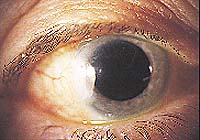Case report: corneal melt observed in a patient with bilateral cataract
The patient received generic diclofenac sodium in one eye and Voltaren in the other eye.
Editor’s note:
This report by J.L. Gayton, MD, is both timely and significant. Although no statistical analysis can be derived from the information given, one is made to realize that there may be significant differences between similar products, even when the same basic drug is used in the formulation. A vehicle in which a medication is dissolved, in some cases, can modify the basic medication’s effect. Even without the basic medication that is dissolved in it, a vehicle or solution may, in and of itself, have a significant beneficial or adverse effect.
Reports such as this one, statistical analysis of a medication’s effects as performed by the American Society of Cataract and Refractive Surgery and a responsible company’s analysis all are essential before any type of product is removed from the marketplace.
Ophthalmic surgeons should use all nonsteroidal medications with caution. There also may be certain patients who are more at risk for corneal melts when nonsteroidal medications are used postoperatively beyond the recommended dosing regimen.
Stephen M. Soll, MD
In our practice, we have been routinely prescribing the brand-name formulation of diclofenac sodium (Voltaren; CIBA Vision) to reduce pain and inflammation following cataract and refractive surgery. We started noticing a small number of patients who were developing severe corneal melts and ulcers, particularly around the incision site.
In investigating this problem, we discovered that local pharmacies were frequently substituting the generic formulation of diclofenac sodium (Falcon, a subsidiary of Alcon; Fort Worth, U.S.A.) for Voltaren. We determined that “all of the corneal melts occurred in patients who received this substitution. In discussing this issue with several other surgeons who also were experiencing an unusually high incidence of corneal melts, we determined that the generic diclofenac sodium was responsible for the increase in epithelial defects and corneal melting.
Case report
 ---Pericardial
graft to repair perforation after corneal melt.
---Pericardial
graft to repair perforation after corneal melt.
One of
our patients who experienced a severe corneal melt, a 72-year-old white woman
with no previous history of corneal problems, had cataract surgery in both eyes
3 weeks apart. By calling the pharmacy, we determined retrospectively that she
received generic diclofenac for the first eye (OD) and Voltaren for the second
eye.
Beginning the day prior to surgery OD, the patient administered one drop of diclofenac four times per day until 2 weeks postoperatively and then twice per day for 2 weeks. The patient also was taking TobraDex (tobramycin; Alcon), bacitracin ointment and GenTeal (CIBA Vision). At 4 weeks postoperatively, the patient developed a temporal corneal melt with 1+ cells. The patient was started on HydroEyes (a nutritional supplement), diclofenac was increased to three times per day, Celluvisc (carboxymethylcellulose; Allergan) and Ciloxan (ciprofloxacin; Alcon) were added, and TobraDex was discontinued. We thought the steroid might be contributing to the corneal melt.
The following day, the melt was 2 mm 3 4 mm at 70% to 80% depth, with 2+ to 3+ cells and flare. All medications were continued except diclofenac. Three days later, the patient complained of foreign body sensation. Visual acuity was reduced to 20/200. The defect was 3 mm x 5 mm with 50% to 80% thinning. Seidel test was positive, with a shallow anterior chamber and 4+ cells. A pericardial graft was performed. Two days later, the anterior chamber still was shallow, although the Seidel test was negative. There were large folds in the endothelium and 4+ cells. The pericardial graft was repeated.
By 11 days after the second pericardial graft, the defect had resolved. A YAG lysis of synechiae was performed. One month post-graft, the patient had 20/40 uncorrected visual acuity and 20/30 best corrected acuity.
The patient had cataract surgery performed on the left eye 3 weeks after the right eye. Voltaren was administered four times per day, beginning with the day prior to surgery, for 2 weeks. The left eye experienced no problems. Voltaren was discontinued after only 2 weeks.
Causes of side effects
Nonsteroidal anti-inflammatory drugs have been used following cataract and refractive surgery not only for the anti-inflammatory effect, but also for their topical analgesic effect. Their use can potentially cause problems because of their tendency to inhibit epithelialization; however, the actual incidence of side effects has been extremely low. Voltaren has been well studied and has been used successfully with a very low incidence of epithelial defects, which are usually of a mild to moderate nature.
When generic diclofenac sodium became widely available, many surgeons, including myself, noted a marked increase in aggressive corneal melts, some requiring suturing or even corneal transplantation. It is likely that the carrier, a vitamin E derivative, causes the diclofenac to be in contact with the cornea for an extended period of time, resulting in a greater likelihood of complications.
Other possible explanations for the increased incidence of corneal melting with the generic version include that it may have a greater anesthetic effect, creating a neurotrophic ulcer, and it may stimulate collagenase, which digests the corneal stroma.
Since the epidemic of corneal melts occurred, Alcon has voluntarily pulled the generic formulation of diclofenac sodium from the market.
For Your Information:
- J.L. Gayton, MD, can be reached at 216 Corder Road, P.O. Box 6479, Warner Robins, GA 31088-3604 U.S.A.; +(1) 912-923-5872; fax: +(1) 912-929-6266. Dr. Gayton has no direct financial interest in any of the products or companies mentioned in this article.
- Stephen M. Soll, MD, is associate clinical professor of surgery/ophthalmology, University of Medicine and Dentistry of New Jersey, Robert Wood Johnson Medical School, Camden, NJ. He can be reached at Soll Eye Associates, 5001 Frankford Ave., Philadelphia, PA 19124 USA; +(1) 215-288-2500; fax: +(1) 215-288-5601.
